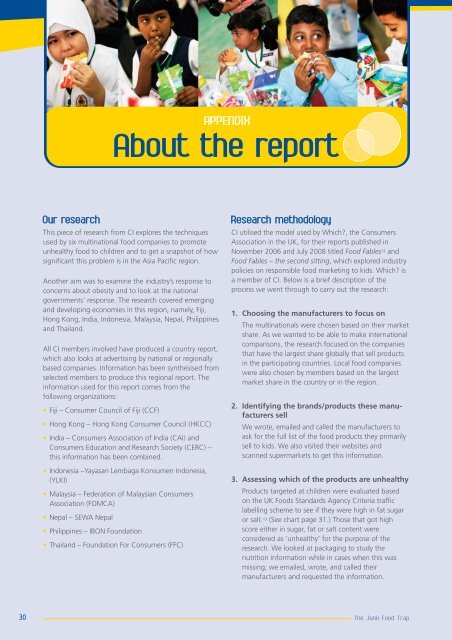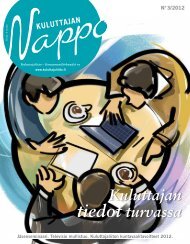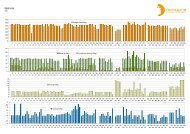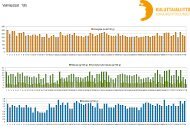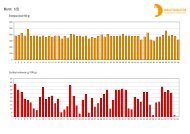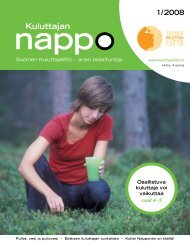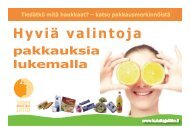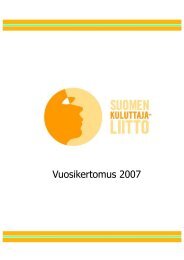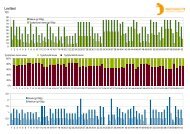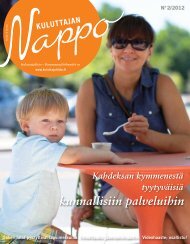Marketing unhealthy food to children in Asia Pacific - Consumers ...
Marketing unhealthy food to children in Asia Pacific - Consumers ...
Marketing unhealthy food to children in Asia Pacific - Consumers ...
- No tags were found...
Create successful ePaper yourself
Turn your PDF publications into a flip-book with our unique Google optimized e-Paper software.
APPENDIXAbout the reportOur researchThis piece of research from CI explores the techniquesused by six mult<strong>in</strong>ational <strong>food</strong> companies <strong>to</strong> promote<strong>unhealthy</strong> <strong>food</strong> <strong>to</strong> <strong>children</strong> and <strong>to</strong> get a snapshot of howsignificant this problem is <strong>in</strong> the <strong>Asia</strong> <strong>Pacific</strong> region.Another aim was <strong>to</strong> exam<strong>in</strong>e the <strong>in</strong>dustry’s response <strong>to</strong>concerns about obesity and <strong>to</strong> look at the nationalgovernments’ response. The research covered emerg<strong>in</strong>gand develop<strong>in</strong>g economies <strong>in</strong> this region, namely, Fiji,Hong Kong, India, Indonesia, Malaysia, Nepal, Philipp<strong>in</strong>esand Thailand.All CI members <strong>in</strong>volved have produced a country report,which also looks at advertis<strong>in</strong>g by national or regionallybased companies. Information has been synthesised fromselected members <strong>to</strong> produce this regional report. The<strong>in</strong>formation used for this report comes from thefollow<strong>in</strong>g organizations:• Fiji – Consumer Council of Fiji (CCF)• Hong Kong – Hong Kong Consumer Council (HKCC)• India – <strong>Consumers</strong> Association of India (CAI) and<strong>Consumers</strong> Education and Research Society (CERC) –this <strong>in</strong>formation has been comb<strong>in</strong>ed.• Indonesia –Yayasan Lembaga Konsumen Indonesia,(YLKI)• Malaysia – Federation of Malaysian <strong>Consumers</strong>Association (FOMCA)• Nepal – SEWA Nepal• Philipp<strong>in</strong>es – IBON Foundation• Thailand – Foundation For <strong>Consumers</strong> (FFC)Research methodologyCI utilised the model used by Which?, the <strong>Consumers</strong>Association <strong>in</strong> the UK, for their reports published <strong>in</strong>November 2006 and July 2008 titled Food Fables 12 andFood Fables – the second sitt<strong>in</strong>g, which explored <strong>in</strong>dustrypolicies on responsible <strong>food</strong> market<strong>in</strong>g <strong>to</strong> kids. Which? isa member of CI. Below is a brief description of theprocess we went through <strong>to</strong> carry out the research:1. Choos<strong>in</strong>g the manufacturers <strong>to</strong> focus onThe mult<strong>in</strong>ationals were chosen based on their marketshare. As we wanted <strong>to</strong> be able <strong>to</strong> make <strong>in</strong>ternationalcomparisons, the research focused on the companiesthat have the largest share globally that sell products<strong>in</strong> the participat<strong>in</strong>g countries. Local <strong>food</strong> companieswere also chosen by members based on the largestmarket share <strong>in</strong> the country or <strong>in</strong> the region.2. Identify<strong>in</strong>g the brands/products these manufacturerssellWe wrote, emailed and called the manufacturers <strong>to</strong>ask for the full list of the <strong>food</strong> products they primarilysell <strong>to</strong> kids. We also visited their websites andscanned supermarkets <strong>to</strong> get this <strong>in</strong>formation.3. Assess<strong>in</strong>g which of the products are <strong>unhealthy</strong>Products targeted at <strong>children</strong> were evaluated basedon the UK Foods Standards Agency Criteria trafficlabell<strong>in</strong>g scheme <strong>to</strong> see if they were high <strong>in</strong> fat sugaror salt. 13 (See chart page 31.) Those that got highscore either <strong>in</strong> sugar, fat or salt content wereconsidered as ‘<strong>unhealthy</strong>’ for the purpose of theresearch. We looked at packag<strong>in</strong>g <strong>to</strong> study thenutrition <strong>in</strong>formation while <strong>in</strong> cases when this wasmiss<strong>in</strong>g; we emailed, wrote, and called theirmanufacturers and requested the <strong>in</strong>formation.30 The Junk Food Trap


